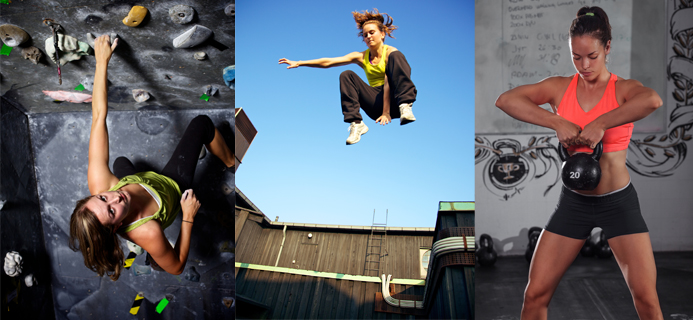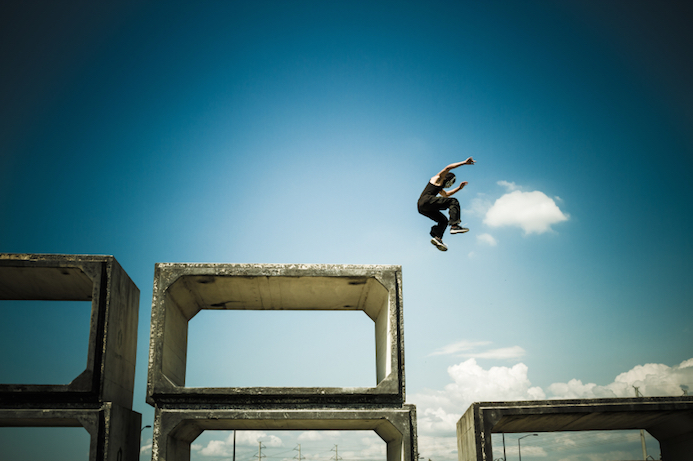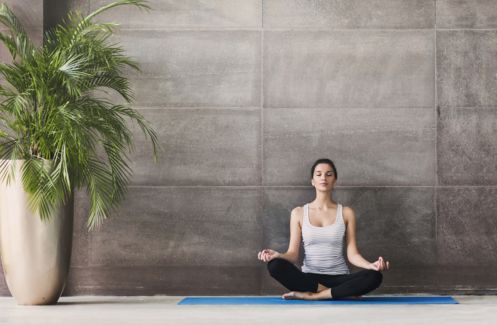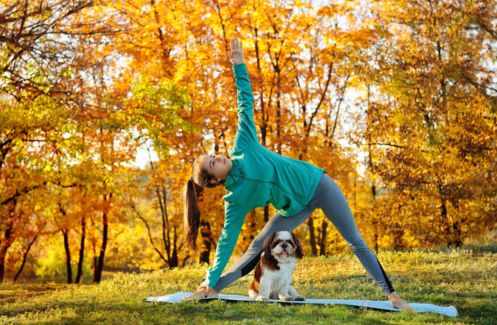Christina Paugger tried bouldering, Parkour and Crossfit, three killer workouts at the forefront of the new Extreme Fit
I always found running on a treadmill boring. Even as a child I never found joy in conventional sports like basketball, football or tennis but instead loved climbing every piece of furniture in the house. But since I can’t climb furniture now without being labeled a complete nutjob, I’ve been searching for fitness options that are more exciting and challenging than running on a treadmill – but more socially acceptable than climbing furniture.
The idea that the perfect workout should involve spending hours and hours on a treadmill has been diminished by trainers such as Jillian Michaels who argue that a High Intensity Interval Training (HIIT), combining strength and cardio, is the way to get results. That’s working out hard and fast to you and me. Now, more and more women are lifting serious weights and turning away from cardio-only exercise plans.
MORE: 5 good reasons for women to lift weights
Moving heavy weight (yours or a weighted object’s) quickly is part of the fun of fitness classes that are gaining popularity in the Capiltal. For example, the first ever indoor Parkour Academy in the UK opened this year in East London with daily Parkour classes that teach people how to move freely through space, jumping, climbing, lifting and crawling through urban environments. Then there’s bouldering, a form of indoor climbing without a harness. And of course, no extreme fit conversation is complete without a mention of Crossfit, a combination of weightlifting and HIIT that’s popular in the US and taking London and the UK by storm. As part of my quest to find challenging and exciting exercise, I tried them all. Here’s what happened:
PARKOUR – jumping off buildings and lifting other people
Parkour, also known as free-running refers to the smooth movement through the built environment. Free runners combine jumping and running to move between obstacles such as walls of buildings or steel scaffolding.
‘Parkour is a lot more engaging for the mind than any other sport or discipline’ says James Adams, coach at Parkour Generations and personal trainer. ‘You have to assess risk a lot more, you have to assess what you are doing and you have to face fear’.
Originally an outdoor discipline, parkour has recently found its way inside, in the UK the first indoor Parkour centre which offers daily lessons opened in October 2014. Indoor parkour is a supplement to outdoor training and gives practitioners the opportunity to get certain challenges that may be hard to find outdoors, for example a wall that’s a particular height and angle. But it is also a good place to learn basic parkour moves. Even though a lot of indoor centres will have soft equipment, such as mats and padding, the Parkour Generations centre is built as close to an outdoor environment as possible, which helps with assessing risk. Performing parkour means moving one’s own bodyweight over obstacles, hence it trains agility as well as strength. I tried the beginner’s class.
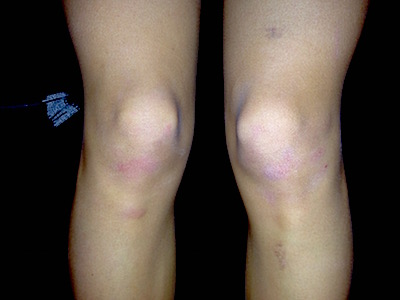
The Chainstore indoor training centre is made from wood, concrete and steel scaffolding. The lack of mats and padding was scary considering I’m quite a clumsy person. We were a group of ten, half of which were female and the class lasted two hours including warm up and stretching at the end. One of the first questions the coach asked was whether anyone had any injuries from last week, which was when I thought ‘What have I gotten myself into?’.
Half an hour after the class, when I was on my way home, my legs started to ache and walking became a challenge.
The warm up included squatting, push-ups and carrying another person across the room multiple times. My arms were shaky and I started to feel exhausted already – we hadn’t even started! The actual training involved working your way around the various blocks of concrete and steel scaffolding using your entire body to move from one obstacle to the next. I felt a thrill while I was hanging from one of the steel bars trying to swing my body forward.
When you’re performing this kind of risky sport there’s no room to think about anything else but what you’re doing in that moment. I hit my knees a few times but other than that there were no injuries. Half an hour after the class, when I was on my way home, my legs started to ache and walking became a challenge. These two hours of parkour resulted in extreme pain for the next couple of days – sitting down and standing up became almost beyond my abilities, so sore were my legs, simple things like going to the loo seemed impossible. But as James said, ‘parkour is unlike any other training method and there is no way you are going to be used to it straight away’.
There is no doubt that this sport trains your entire body and will get you fit. There are parkour centres scattered around the country but if there isn’t a centre in your area Parkour Generations have launched a campaign called she can TRACE (#shecanTRACE) in order to encourage more women to do parkour. She can TRACE allows women to find each other and form groups to perform parkour in their area. This is a tool women can use to form groups to self-train. Once you know the basic moves you can get a great workout out of just a wall – no expensive gym membership needed.
https://www.youtube.com/watch?v=K4HcSd2p-4E
What is it: The smooth movement through urban space, using no equipment at all.
You will like it if: You like running, jumping and aren’t afraid of heights.
Cost: £10 for a drop in class
Try it here: Parkour Generations
BOULDERING – the new way to get a killer core
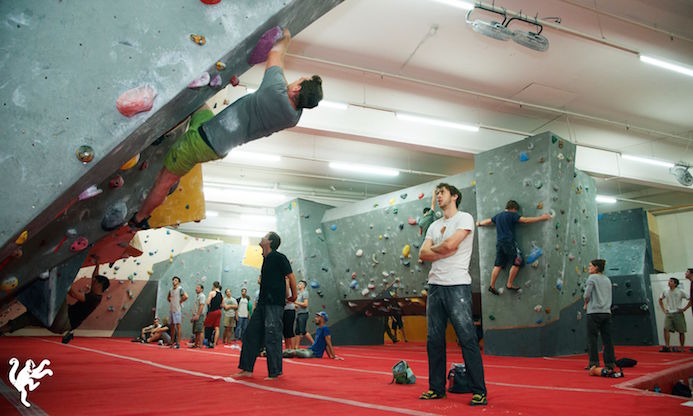
When you hear indoor climbing you probably imagine a very high wall and someone climbing it wearing a harness. Well, that’s a popular form of indoor climbing but bouldering is different. First, the walls are usually four to five meters high and second, there is no harness. Crash mats on the floor are a safety measure to prevent injuries. Bouldering is in fact a type of problem-solving, you can’t simply grab any boulder you want in order to get to the top, once you are set on a particular climb – which is called a problem – you need to grab the same colouring of boulders to get to the top.
even though the wall was only four meters high it felt like I was on the third floor of a building
The first time I tried bouldering I had the biggest adrenaline rush ever because even though the wall was only four meters high it felt like I was on the third floor of a building. After a few climbs with other beginners and a teacher I became more confident and the fun kicked in.
With each boulder that I managed to grab I got a feeling of accomplishment. It was an incredible experience because I felt so confident and strong after the session. I know that bouldering really challenged me on a physical level because my entire body was aching for three days, particularly my upper back, shoulders, forearms and sides of my torso (which felt like I’ve been run over by a car).
I took to bouldering and have been going regularly and with each time I recognise progression in my skills. Bouldering is an adrenaline-laden sport and the endless challenge ensures that each climb is different. ‘A lot people have replaced the gym with climbing’ says Emilia Shaftesbury, centre manager at the Arch Climbing Wall ‘you work your legs and core, so it’s an all body workout’.
There are 3,800 indoor climbing walls nationwide, to locate a wall near you click here.
What is it: Indoor climbing without a harness on a wall no higher than 5 metres.
You will like it if: You enjoy problem solving and aren’t afraid of heights.
Cost: £10 single peak time
Try it here: The Arch Climbing Wall
CROSSFIT – lifting Olympic-style and doing gymnastics (until you die)
CrossFit is a combination of HIIT and olympic weight-lifting. This is not your average workout, using your entire body to lift weight either in the form of an olympic bar, kettlebell or slamball really builds strength. CrossFit is unique in the sense that it is a franchise, hence not all gyms offer Crossfit workouts.
Even though it has been around for 15 years CrossFit only started to become trendy in the past couple of years, especially in the UK. Practitioners complete what is called a Workout of the Day (WOD) which is a set of exercises repeated multiple times. WODs are posted online daily (and they’re the same worldwide), hence you don’t need to attend a class to do these workouts, you can simply do them at the gym or at home if you have all the relevant equipment.
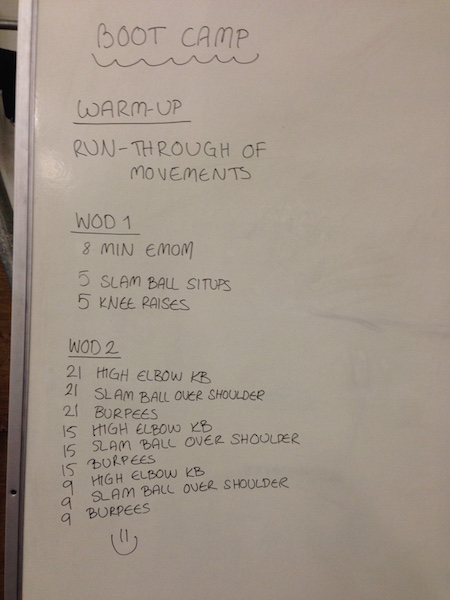
The class I attended was a Bootcamp class, which is supposed to give people a taste of what crossfit is like, which means the moves are easier modifications and weights aren’t as heavy as they would otherwise be in an ordinary class.
The gym was located in trendy East London under the arch of a railway in Bethnal Green and the class started at 7am – which meant waking up at the crack of dawn.
The workout was structured into a warm up followed by two WODs. It was ladies only, which made it a bit less intimidating. I do feel a bit awkward going into the weights area in the gym as a 5’4″ woman who is rather petite, being surrounded by men who lift weights as heavy as my own body.
Being amongst other women who haven’t done weight-lifting before certainly took the edge off.
This workout was no joke, as if sit-ups aren’t hard enough, participants were asked to do sit-ups holding a 8-12kg slamball – a ball that doesn’t bounce when it hits the ground – behind their heads whilst lying on their back, sitting up and bringing the slamball forward between their feet.
What made this workout incredibly hard was the level of intensity and the amount of repetitions. The stopwatch on the wall dictated how much time everyone had left to finish a set of exercises. And this was only a bootcamp, it wasn’t even the real deal.
Editor Anna Magee has tried a beginners’ CrossFit class learning the correct squat and bar lifting techniques. In CrossFit you don’t just attended any class, it is recommended that you learn the right techniques step by step. Read Anna’s full review of the Beginners level 1.1 CrossFit class here.
What is it: A workout which combines High Intensity Interval Training with different types of weight lifting.
You will like it if: You enjoy very intense training, weight lifting and being part of a community.
Cost: £15 Single session pass
Try it here: CrossFit London
MORE: 13 new fitness trends for 2015
Like this article? Sign up to our newsletter to get more articles like this delivered straight to your inbox.



